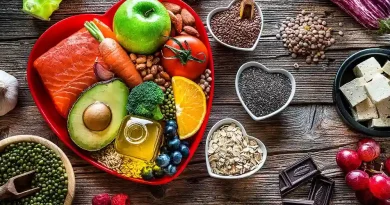From Farm to Fork: Sustainable Eating with Healthy Dinner Ideas
In a world increasingly conscious of its carbon footprint and the sustainability of its food sources, the concept of ‘farm to fork’ eating is gaining significant momentum. This approach not only champions the consumption of locally sourced, seasonal produce but also underlines the importance of understanding the journey of food from its origin to our plates. This article delves into the essence of sustainable eating and offers a variety of healthy dinner ideas that align with this philosophy.
Understanding Farm to Fork
The farm-to-fork concept, at its core, emphasizes a direct link between producers and consumers. It’s about reducing the food miles, supporting local farmers, and being mindful of the environmental impact of food production. This approach fosters a closer connection with the food we eat, ensuring that it’s not only fresher and more nutritious but also has a lesser environmental impact compared to food that travels long distances.
Benefits of Sustainable Eating
Environmental Preservation
By choosing local and seasonal foods, we significantly reduce the carbon footprint associated with long-distance transportation. This practice also supports biodiversity as farmers are more likely to grow a wider variety of crops.
Healthier Choices
Locally sourced food is often fresher, retaining more nutrients. Additionally, sustainable farms typically use fewer pesticides, leading to cleaner and healthier food on your plate.
Economic Support
Buying from local farms and markets boosts the local economy and supports small-scale farmers, ensuring that they can continue to provide quality produce.
Implementing Sustainable Eating Practices
1. Shop Locally
Start by visiting local farmers’ markets or joining a community-supported agriculture (CSA) program. This not only gives you access to fresh, seasonal produce but also helps you build a relationship with those who grow your food.
2. Seasonal Eating
Align your diet with the seasons. Eating what’s in season is more sustainable and often more nutritious and flavorful.
3. Reduce Meat Consumption
Consider incorporating more plant-based meals into your diet. The production of plant-based foods generally requires fewer natural resources than meat.
4. Minimize Food Waste
Plan your meals and buy only what you need. Use leftovers creatively and compost organic waste to reduce your environmental impact.
Healthy Dinner Ideas
Now, let’s translate these principles into practice with some healthy, sustainable dinner ideas:
1. Roasted Vegetable Quinoa Bowl
Ingredients: Seasonal vegetables (e.g., zucchini, bell peppers, tomatoes), quinoa, olive oil, herbs, lemon juice.
Method: Roast the vegetables with a drizzle of olive oil and your choice of herbs. Serve over cooked quinoa, dressed with lemon juice. This meal is high in protein and fiber, and it’s customizable based on what’s in season.
2. Lentil and Mushroom Stew
Ingredients: Lentils, mushrooms, onions, garlic, vegetable broth, herbs.
Method: Sauté onions and garlic, add mushrooms, then lentils and broth. Simmer until lentils are tender. This hearty stew is perfect for colder months and is rich in plant-based protein.
3. Farm Fresh Salad with Grilled Chicken
Ingredients: Mixed greens (like arugula or spinach), seasonal vegetables (e.g., cucumber, radishes), grilled chicken breast, olive oil, balsamic vinegar.
Method: Toss the greens and chopped vegetables with olive oil and balsamic vinegar. Top with sliced grilled chicken. This salad is a great way to enjoy fresh produce with a lean protein source.
4. Stir-Fried Tofu with Seasonal Vegetables
Ingredients:
Tofu, assorted seasonal vegetables (e.g., bell peppers, snap peas, broccoli), soy sauce, ginger, garlic, sesame oil.
Method: Press and cube the tofu, then stir-fry in sesame oil until golden. Add minced garlic and ginger, then the chopped vegetables. Finish with a splash of soy sauce for a quick, nutritious meal rich in protein and essential nutrients.
5. Whole Wheat Pasta with Seasonal Vegetable Sauce
Ingredients: Whole wheat pasta, seasonal vegetables (e.g., tomatoes, spinach, zucchini), garlic, olive oil, fresh basil.
Method: Sauté garlic in olive oil, add chopped vegetables, and cook until tender. Blend into a sauce and serve over cooked whole wheat pasta. Garnish with fresh basil for a heart-healthy, fiber-rich meal.
6. Baked Fish with Herb-Infused Quinoa
Ingredients: Sustainable fish fillets (like trout or salmon), quinoa, fresh herbs (e.g., parsley, dill), lemon, olive oil.
Method: Bake the fish fillets with lemon slices and olive oil. Cook quinoa and mix in chopped fresh herbs. This meal is an excellent source of omega-3 fatty acids and complete protein.
7. Vegetable Curry with Brown Rice
Ingredients: Assorted vegetables (e.g., cauliflower, carrots, peas), coconut milk, curry powder, brown rice, onions, garlic.
Method: Sauté onions and garlic, add vegetables, and cook with curry powder and coconut milk. Serve over cooked brown rice for a comforting, nutrient-packed meal.
8. Grilled Vegetable and Hummus Wraps
Ingredients: Whole grain wraps, hummus, seasonal grilled vegetables (e.g., eggplant, bell peppers, onions), mixed greens, tzatziki sauce.
Method: Spread hummus on wraps, add grilled vegetables and greens, and a dollop of tzatziki. Roll up for a quick, nutritious meal that’s perfect for on-the-go dining.
9. Seasonal Fruit and Cheese Platter
Ingredients: A variety of seasonal fruits (e.g., apples, grapes, berries), a selection of local cheeses, whole-grain crackers.
Method: Arrange sliced fruits, cheeses, and crackers on a platter. This simple, elegant meal is great for a light dinner or a shared appetizer and is a wonderful way to showcase the flavors of the season.
Conclusion
Adopting a farm-to-fork approach in our eating habits is not only beneficial for our health and the environment but also supports local economies and promotes biodiversity. By making conscious choices about what we eat and where it comes from, we can enjoy a rich array of healthy, delicious meals while contributing to a more sustainable world. The dinner ideas provided here are just a starting point – the possibilities are endless when you begin to explore the bounty of local and seasonal foods available. Let your culinary creativity flourish and savor the journey from farm to fork.




